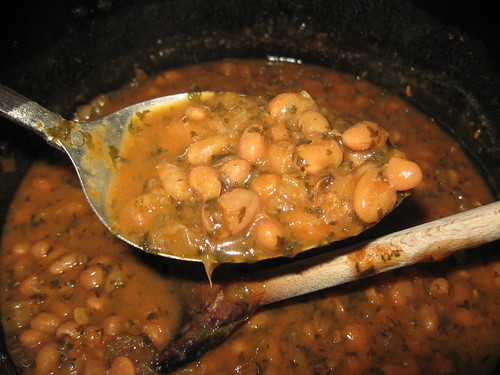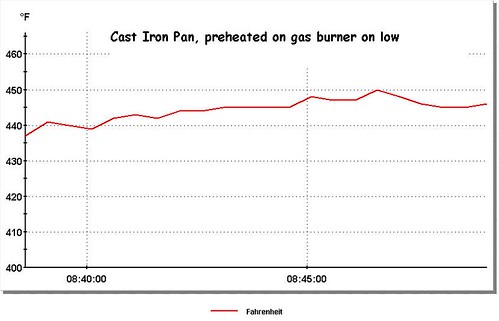In a pinch, we eat Bush's Baked Beans. Not bad, but I hate the fact they're fat free. Fat free means they unnaturally remove the fat and add a shitload of sweeteners to get the right characteristics. In the process, they make a calorically-dense bean because they want to claim fat free. Bush underestimates the consumer.
Beans need fat. And, they shouldn't be as sweet as candy. I made a small batch for (hot)dog night a few days ago. Pretty easy.
Ever since Andrew told me of Paula Wolfert's Slow Mediterranean Kitchen, I've used my oven @ 200F overnight as a slow cooker. Ovens are so well insulated, it barely kicks on to maintain 200F. I used this to make my most delectable baked beans the other night and they were yummy.
Baked beans:
Cook a couple strips of bacon slowly (in ovenproof cookware) to render the fat. Eat bacon and drift into a momentary haze of ecstasy. In the hot fat, saute onion, pepper and celery, dump in 1/2 pound great northerns dry, add parsley, dry mustard, brown sugar, worcestershire (did I spell it right?), salt (ca. 2 t), pepper, ketchup and place in 200F oven for about 10 hours. Toss in fridge the next morning and reheat while dogs are cooking. Serve.
This preparation is ideal eaten near room temperature. Not too sweet or tangy. Vary quantities of ingredients to suit your taste.
4.29.2009
Baked Beans
4.15.2009
Cast Iron Skillet, low heat
When I cook bacon, I alter the (gas) burner real low so the bacon slowly renders its fat, becomes nice and crispy and the fat doesn't splatter all over the stove. It's a slow process that recently made me think about the heat source.
I've often wondered if a pan goes on a burner, does it constantly go up in temperature, or does it level off? Given that ignited natural gas must be over a 1,000F or so, I wondered what temp a skillet would get at vaious levels of gas on the burner.
I fired up a cast iron skillet and sandwiched a thermocouple probe on the surface with another smaller skillet to hold it securely on the surface. After a long pre-heating at a setting of 3 out of 8 on a 10K BTU burner, I was amazed at the stability of the temperature. The y-axis is expanded quite a bit and the duration of this brief, but not trivially short, test is over 10 minutes.
Seems kind of trivial once the data's in, but I couldn't figure it out before doing the expt.
This post should make my last 5 readers run for another blog.
Doctor Fire for a well-documented piece on flame temperature determination.
4.12.2009
Where's the first video, ya bastahd?
The baguette has been a significant focus in my life for literally decades. It serves us not only as a daily bread, but is more about community. Food to share - with friends and family. The "recipe" for it is the motivation for this site. There are no bread recipes as far as I'm concerned. Bread, while it may only take a few minutes to toss together, is not a recipe, it's a way of life.
Enough of the philosophical, just had to justify another in an infinite series of posts on my obsession.
The baguette plays out in 3 acts. All 3 change gradually over time as experience is accrued. Currently, I'm concerned with modifications to act 3. The humidity applied during baking. After talking to Andrew last night, we feel the initial humidity as gleaned from the early pages of Reinhart's Baker's Apprenctice is more critical than we may have thought.
I've routinely humidified my preheated electric oven with 1 cup water tossed in at the beginning and occasionally, I dabbled in moistening the exterior of the loaf itself. I'm in the process of configuring alternative conditions. I'm now trying the baking in the lower third of the oven (as usual), beneath the perforated aluminum baking sheet is a half sheet baking pan with 1 cup of water (placed in it a couple minutes before baking) and the sides of the oven doused with a stream of water just as the loaf goes in. Too much for words, this will show up in a future video if it works. Thanks for the talk last night Andrew. Someday we'll get that voluminous, airy inside, razor-sharp crusted baguette.
And the first act video? Soon, I promise. It's the only act that never changes.
ps, According toWikipedia and the formula for volume of a cylinder, the density of a French baguette should be 10 mL/g (that is not a mistake, typically density is given in units of g/mL, but the inverted dimension is a more useful metric). My loaves this morning were about 4.4 mL/g - loooong way to go. I think I actually created an environment that was too humid!! Very useful though. Going in the wrong direction for volume is useful too.
4.04.2009
New Pizza Recipe/Video - get ready (to Flop)
Some weeknight, I'm going to make a 12" pizza with nice bubbles and a beautiful airy crust. If you want to follow along, put 2 cups flour, 1 cup water, 1/2 t dry yeast (any kind) and 1 t salt (regular or 1.5 t kosher) in a container, mix into a ball, don't bother kneading and toss in the fridge until about Tuesday night. It's gonna be awesome.
Update
I filmed the entire thing and the final pizza was too moist inside. The slack dough was simply too wet. Even cooking in an amply preheated 550-deg-F oven, it was still under done in the middle despite the nice bubbles on top.
I'm posting the vid because the method will be identical and I'll simply replace the dough recipe. Sorry for wasting your flour all. Agony of defeat hurts. If you feel like losing 8 minutes of your life you will never, ever get back, here it is.






